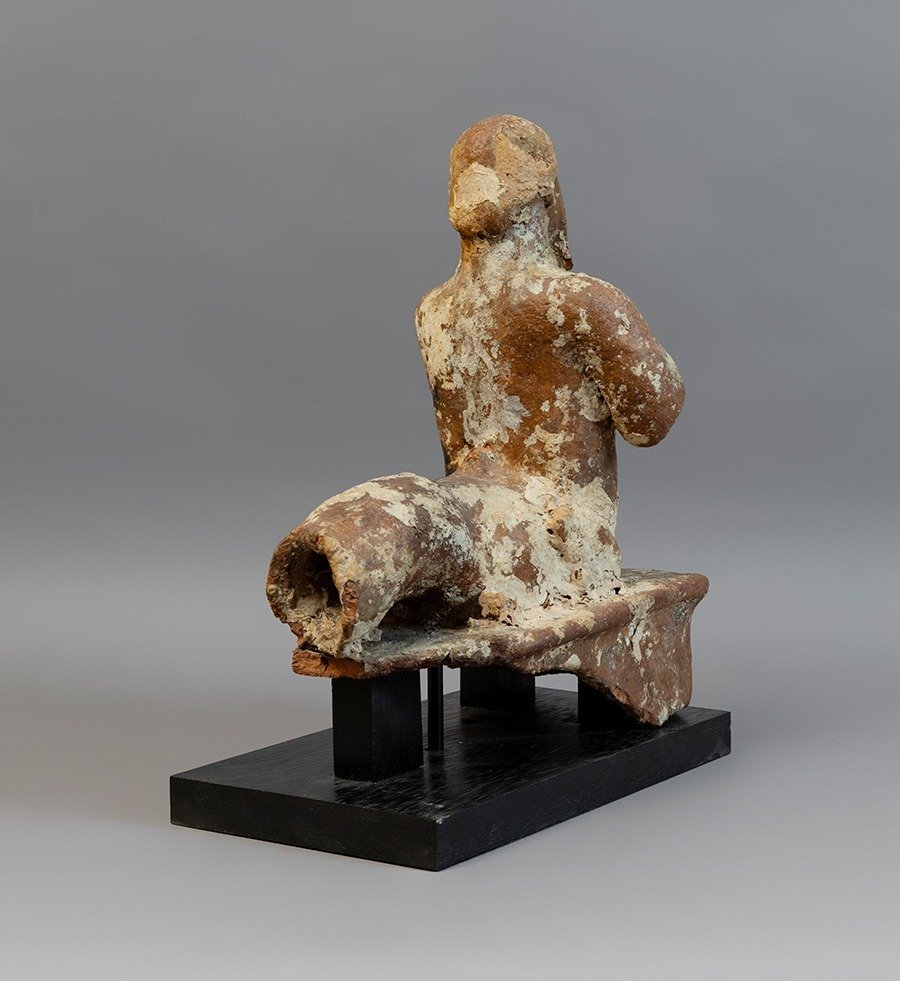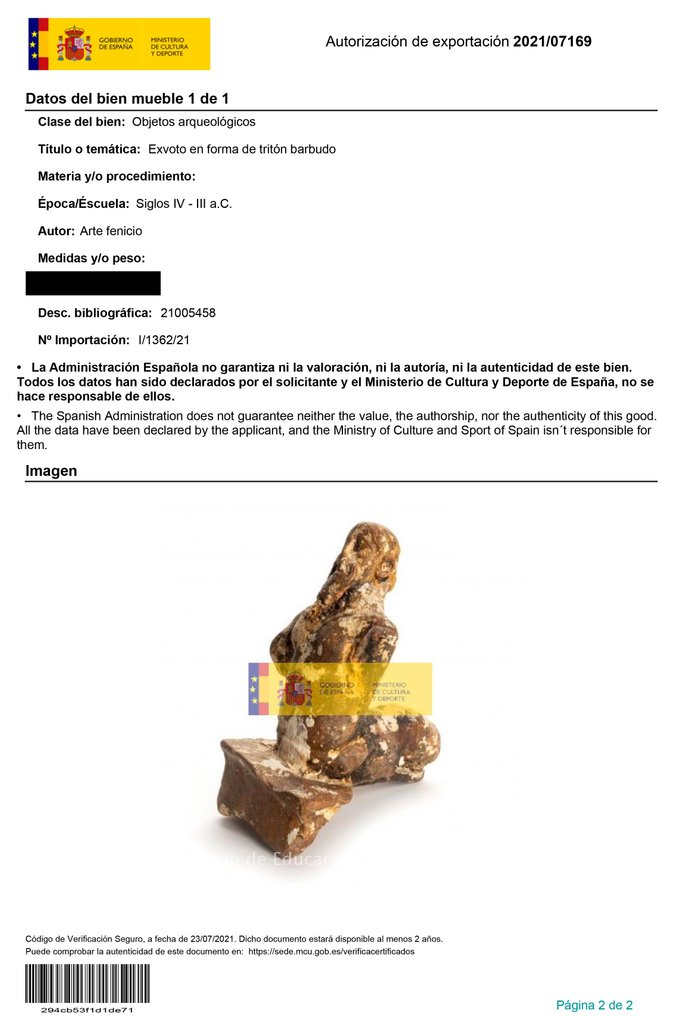Magnífica la entrega y el objeto. Perfecta la sonido del sibato
Übersetzung ansehenPhönizisch Terracotta Ex-Voto oder Idol mit der Darstellung eines Triton. 6.-4. Jahrhundert v. Chr. 32 cm H. Alte
Nr. 88181123






Important figure of an Ex-Voto or Idol depicting a Triton.
Phoenician, c. 6th - 4th century B.C.
32 cm H and 27 cm L. (without stand) 36 cm H with stand.
- STAND DISPLAY INCLUDED -
PROVENANCE: Maurice Druon Collection, Paris 1918 - 2009. Druon was a French writer and academic, Minister of Culture of France between 1973 and 1974.
CONDITION: Good state, see photos, unrestored.
DESCRIPCTION:
It is representing a Hybrid creature, the upper half being a man's body and lower half is a fish's body, specifically the tail.
It is presented on a base made in the form of an altar. The human torso is naked, with fine features such as the chest and the navel. The face has a serene expression with large almond shaped eyes highlighted by eyelids that are marked with a thick line, this being a Phoenician interpretation that is of clear Greek Archaïc inspiration.
At the height of the chin, there is a false beard, reminiscent of that used by the Egyptian pharaohs as a sign of power. The hair is worked in a smooth way, delimited in all its contour by a line of geometric design that frames the form of the man's head, this in turn links with the classic Greek tradition. In this way we can see how it is a piece that eclectically combines influences from styles such as Greek or Egyptian, the result of the Phoenicians' contacts with these cultures.
With respect to its iconography, it could be Yam, the god of the sea in the Canaanite pantheon. Yam is a deity of the sea and his palace is in the abyss associated with the depths. He represents the primordial chaos, the power of the sea, uncontainable and furious; he is seen as the god of dominant storms and the disasters they cause, and he was an important deity for the maritime Phoenicians.
This figure belongs to a group of Phoenician terracottas that remained 2,500 years under the sea until the 1960s when a fortuitous discovery made it possible to find all the pieces. One of the hypotheses that are being considered is that the Phoenicians, faced with the siege that the city suffered by Alexander the Great, loaded their ships with these pieces in order to escape from the city with their most precious goods. However, a storm must have surprised them a few kilometres from the coast, causing the ship to sink and the terracotta boats it contained to sink.
The sea god Triton, of Greek origin, is depicted on this Phoenician votive offering with a stylised face framed by a beard that gives him an aristocratic bearing. The muscular torso curves at the level of the hips, growing to the back with a long tail. He probably originally could have been blowing a conch shell. It follows Greek precepts in terms of representation, with the torso of a man and the lower part of a fish. Legend has it that Triton lived with his parents, Poseidon and Amphitrite, in a golden palace at the bottom of the sea. He is often depicted with a conch shell that he blows like a trumpet. The Phoenician culture, and later the Romans, inherited this figure and reinterpreted its symbolism. Here, adopting the role of an ex-vota, he gives good fortune to sailors.
Notes:
The seller guarantees that he acquired this piece according to all national and international laws related to the ownership of cultural property. Provenance statement seen by Catawiki.
The piece includes authenticity certificate.
The piece includes Spanish Export License.
THE MINISTRY OF CULTURE FROM SPAIN ASKS ALL SELLERS FOR INVOICES OR OTHER DOCUMENTATION ABLE TO PROVE THE LEGALITY OF EACH ITEM BEFORE PROVIDING AN IMPORT OR EXPORT LICENSE.
Der Verkäufer stellt sich vor
Important figure of an Ex-Voto or Idol depicting a Triton.
Phoenician, c. 6th - 4th century B.C.
32 cm H and 27 cm L. (without stand) 36 cm H with stand.
- STAND DISPLAY INCLUDED -
PROVENANCE: Maurice Druon Collection, Paris 1918 - 2009. Druon was a French writer and academic, Minister of Culture of France between 1973 and 1974.
CONDITION: Good state, see photos, unrestored.
DESCRIPCTION:
It is representing a Hybrid creature, the upper half being a man's body and lower half is a fish's body, specifically the tail.
It is presented on a base made in the form of an altar. The human torso is naked, with fine features such as the chest and the navel. The face has a serene expression with large almond shaped eyes highlighted by eyelids that are marked with a thick line, this being a Phoenician interpretation that is of clear Greek Archaïc inspiration.
At the height of the chin, there is a false beard, reminiscent of that used by the Egyptian pharaohs as a sign of power. The hair is worked in a smooth way, delimited in all its contour by a line of geometric design that frames the form of the man's head, this in turn links with the classic Greek tradition. In this way we can see how it is a piece that eclectically combines influences from styles such as Greek or Egyptian, the result of the Phoenicians' contacts with these cultures.
With respect to its iconography, it could be Yam, the god of the sea in the Canaanite pantheon. Yam is a deity of the sea and his palace is in the abyss associated with the depths. He represents the primordial chaos, the power of the sea, uncontainable and furious; he is seen as the god of dominant storms and the disasters they cause, and he was an important deity for the maritime Phoenicians.
This figure belongs to a group of Phoenician terracottas that remained 2,500 years under the sea until the 1960s when a fortuitous discovery made it possible to find all the pieces. One of the hypotheses that are being considered is that the Phoenicians, faced with the siege that the city suffered by Alexander the Great, loaded their ships with these pieces in order to escape from the city with their most precious goods. However, a storm must have surprised them a few kilometres from the coast, causing the ship to sink and the terracotta boats it contained to sink.
The sea god Triton, of Greek origin, is depicted on this Phoenician votive offering with a stylised face framed by a beard that gives him an aristocratic bearing. The muscular torso curves at the level of the hips, growing to the back with a long tail. He probably originally could have been blowing a conch shell. It follows Greek precepts in terms of representation, with the torso of a man and the lower part of a fish. Legend has it that Triton lived with his parents, Poseidon and Amphitrite, in a golden palace at the bottom of the sea. He is often depicted with a conch shell that he blows like a trumpet. The Phoenician culture, and later the Romans, inherited this figure and reinterpreted its symbolism. Here, adopting the role of an ex-vota, he gives good fortune to sailors.
Notes:
The seller guarantees that he acquired this piece according to all national and international laws related to the ownership of cultural property. Provenance statement seen by Catawiki.
The piece includes authenticity certificate.
The piece includes Spanish Export License.
THE MINISTRY OF CULTURE FROM SPAIN ASKS ALL SELLERS FOR INVOICES OR OTHER DOCUMENTATION ABLE TO PROVE THE LEGALITY OF EACH ITEM BEFORE PROVIDING AN IMPORT OR EXPORT LICENSE.
Der Verkäufer stellt sich vor
- 818
- 10
- 1
very well packed with all the documents included, thnks
Übersetzung ansehenGreat object. Really beautiful. Quick delivery. Excellent.
Übersetzung ansehenSuperbe objet, Service d'Arqueologia Ancient Art excellent et rapide. Jaume Bagot toujours parfait .
Übersetzung ansehenTodo perfecto gracias
Übersetzung ansehenNice item all ok A+++
Übersetzung ansehenThank you for this Oinochoe, one question: did you as promised read my post!
Übersetzung ansehenVery cooperative in every aspect of the transaction.
Übersetzung ansehenAlways a great pleasure!
Übersetzung ansehenFine quality, good service. Thanks.
Übersetzung ansehenMuy amables, muy bien todo. Gracias
Übersetzung ansehenAlles bestens
Übersetzung ansehenexactly as described and shipped safely and punctually.
Übersetzung ansehenschnelle Lieferung sehr sichere Verpackung alles bestens
Übersetzung ansehentres bel objet je le recherchai depuis longtemps envoi rapide et protégé je pense qu'il y aura d'autres achats avec ce vendeur merci +++++++
Übersetzung ansehenEinfach nur toll
Übersetzung ansehenTodo perfecto
Übersetzung ansehenottimo
Übersetzung ansehenperfetto
Übersetzung ansehentop oggetto bellissimo grazie 💯💯💯💯💯💯 :-)
Übersetzung ansehenI bought this beautiful artifact together with artifact from Mr. Bagot but although it is clearly stated on his shipping page that when purchasing multiple artifacts i paid the double package costs
Übersetzung ansehenI bought this beautiful artifact together with artifact from Mr. Bagot but although it is clearly stated on his shipping page that when purchasing multiple artifacts i paid the double package costs
Übersetzung ansehenBel objet, bien emballé. Parfait.
Übersetzung ansehenwonderful faiece and very fast shipping.thanks a lot
Übersetzung ansehenJ Bagot es un profesional excelente. Sus artículos son de gran calidad, se incluye la documentación necesaria y el embalaje se realiza con esmero. Le recomiendo encarecidamente.
Übersetzung ansehen- 818
- 10
- 1
Magnífica la entrega y el objeto. Perfecta la sonido del sibato
Übersetzung ansehenDisclaimer
Der Verkäufer garantiert und kann belegen, dass das Objekt legal erworben wurde. Der Verkäufer wurde von Catawiki darüber informiert, dass er die Unterlagen, die gemäß den Gesetzen und Vorschriften seines Landes erforderlich sind, zur Verfügung stellen muss. Der Verkäufer garantiert, dass er berechtigt ist, das Objekt zu verkaufen/auszuführen. Der Verkäufer wird dem Käufer alle Informationen, die zur Provenienz des Objekts vorliegen, zur Verfügung stellen. Der Verkäufer versichert, dass alle erforderlichen Genehmigungen eingeholt wurden/werden. Der Verkäufer wird den Käufer unverzüglich über etwaige Verzögerungen bei der Einholung dieser Genehmigungen informieren.
Der Verkäufer garantiert und kann belegen, dass das Objekt legal erworben wurde. Der Verkäufer wurde von Catawiki darüber informiert, dass er die Unterlagen, die gemäß den Gesetzen und Vorschriften seines Landes erforderlich sind, zur Verfügung stellen muss. Der Verkäufer garantiert, dass er berechtigt ist, das Objekt zu verkaufen/auszuführen. Der Verkäufer wird dem Käufer alle Informationen, die zur Provenienz des Objekts vorliegen, zur Verfügung stellen. Der Verkäufer versichert, dass alle erforderlichen Genehmigungen eingeholt wurden/werden. Der Verkäufer wird den Käufer unverzüglich über etwaige Verzögerungen bei der Einholung dieser Genehmigungen informieren.









